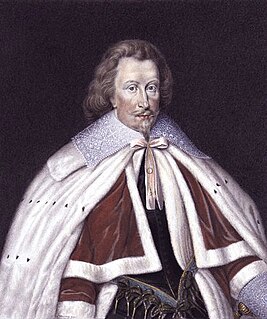Charles Cavendish, Viscount Mansfield (c. 1626 – June 1659) was an English politician who sat in the House of Commons from 1640 to 1644. He supported the Royalist cause in the English Civil War.

The House of Commons of England was the lower house of the Parliament of England from its development in the 14th century to the union of England and Scotland in 1707, when it was replaced by the House of Commons of Great Britain. In 1801, with the union of Great Britain and Ireland, that house was in turn replaced by the House of Commons of the United Kingdom.

The English Civil War (1642–1651) was a series of armed conflicts and political machinations between Parliamentarians ("Roundheads") and Royalists ("Cavaliers") over, principally, the manner of England's governance. The first (1642–1646) and second (1648–1649) wars pitted the supporters of King Charles I against the supporters of the Long Parliament, while the third (1649–1651) saw fighting between supporters of King Charles II and supporters of the Rump Parliament. The war ended with the Parliamentarian victory at the Battle of Worcester on 3 September 1651.
Viscount Mansfield was the eldest son and heir of William Cavendish, 1st Duke of Newcastle-upon-Tyne and his first wife, Elizabeth Basset of Blore. [1] He was known as Viscount Mansfield, his father's courtesy title.
In November 1640, Mansfield was elected Member of Parliament for East Retford in the Long Parliament. [2] He was disabled from sitting in 1644. He went into exile with his father, and returned to England in 1659. [1]
East Retford was a parliamentary constituency in Nottinghamshire, which elected two Members of Parliament (MPs) to the House of Commons for the first time in 1316, and continuously from 1571 until 1885, when the constituency was abolished. Although East Retford was technically a parliamentary borough for the whole of its existence, in 1830 its franchise had been widened and its boundaries had been extended to include the whole Wapentake of Bassetlaw as a remedy for corruption among the voters, and from that point onward it resembled a county constituency in most respects.

The Long Parliament was an English Parliament which lasted from 1640 until 1660. It followed the fiasco of the Short Parliament which had convened for only three weeks during the spring of 1640, and which in turn had followed an 11-year parliamentary absence. In September 1640, King Charles I issued writs summoning a parliament to convene on 3 November 1640. He intended it to pass financial bills, a step made necessary by the costs of the Bishops' Wars in Scotland. The Long Parliament received its name from the fact that, by Act of Parliament, it stipulated it could be dissolved only with agreement of the members; and, those members did not agree to its dissolution until 16 March 1660, after the English Civil War and near the close of the Interregnum.
Mansfield married Elizabeth Rogers, daughter of Richard Rogers and Anne Cheek. [3] Mansfield died at the age of 32 while his father was still alive. His younger brother Henry succeeded their father as second duke of Newcastle. [1]
Richard Rogers was an English politician who sat in the House of Commons from 1640 to 1642. He supported the Royalist side in the English Civil War.

Henry Cavendish, 2nd Duke of Newcastle-upon-Tyne, KG, PC, styled Viscount Mansfield until 1676, was an English politician who sat in the House of Commons from 1660 to 1676, and then inherited the dukedom.











